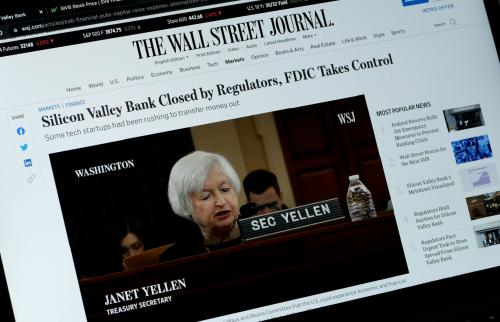The Hutchins Center hosted an event on the growth of private credit on April 4 at Brookings. Video is available here.
Private credit (also known as direct lending) is generally defined as lending by non-bank financial institutions—including private equity firms and alternative asset managers—most often to small and mid-sized businesses, who are often highly leveraged and generally cannot borrow in corporate bond markets. For borrowers, it is an alternative to traditional bank loans. Although private credit is a small slice of overall business financing, it has been growing very fast, raising concerns among some banks about the competition and among some regulators about risks to financial stability. This post describes the recent evolution of private credit and the issues that it raises.
How does private credit differ from traditional bank lending and private equity?
Banks engage in liquidity transformation: They take short-term deposits from savers and convert these deposits into long-term loans, operating as intermediaries between savers and borrowers. Banks often sell the loans to investors, a process known as syndication or securitization.
Private equity firms raise long-term capital from investors, typically high-wealth individuals and institutional investors like pension funds and insurance companies. The private equity firms then purchase equity in businesses, often buying entire firms.
Private credit funds—like private equity—raise capital from investors, but they make loans rather than buying equity. Most private credit funds are not leveraged, but a minority do borrow money or use derivatives to enhance their returns. Confronting competition from private credit funds, parent companies of some traditional banks, such as JPMorgan, have launched platforms to match investors with business borrowers.
How big is private credit?
Private credit has grown rapidly since the 2008 Global Financial Crisis. According to Preqin, a London-based financial data and analytics firm, private credit grew globally from approximately $375 billion in assets under management globally to over $1.6 trillion by March 2023. BlackRock projects private credit will exceed $3.5 trillion by 2028. As the chart below shows, roughly 40% of private credit funds invest primarily in the U.S. Europe is the other big player.
How does this compare to the size of other lending markets? Total non-financial business debt in the U.S. exceeds $21 trillion, according to the Federal Reserve. U.S. banks had about $2.7 trillion in commercial and industrial loans at year-end 2023.
Why has private credit grown?
Investors. Private credit began expanding in the wake of the 2008 financial crisis. With interest rates near zero, returns to government and corporate bonds were unattractive to institutional investors and wealthy individuals. In a phenomenon known as “reach for yield,” some investors turned to riskier assets that offered higher interest rates, including private credit funds. An IMF snapshot with 2022 data found that pension funds (28%), foundations and endowments (21%), and wealthy families (19%) accounted for more than two-thirds of the investments in U.S. private credit funds.
Business borrowers. Firms in search of funds have also driven the expansion of private credit. Private credit funds advertise their ability to provide loans to businesses quickly, on flexible terms, and with pricing available to borrowers upfront. These loans are particularly attractive to borrowers that aren’t big or mature enough to issue bonds and, for various reasons, are unattractive to traditional banks.
Banks. Following the 2008 crisis, banks pulled back from business lending, in part driven by heightened regulatory scrutiny. Private credit took up the slack. More recently, banks have become pickier about to whom they will lend. Private credit funds have stepped in, ushering in what some are calling the “golden age of private credit.” As money-manager PIMCO puts it: “In the wake of a bank retreat, demand for capital has outstripped supply, reducing competition in many markets and creating new opportunities and a potentially stronger position for private credit investors.”
Critics of increases in bank capital requirements that U.S. regulators are proposing—including the big banks, Fed Governor Christopher Waller, and Sen. J.D. Vance (R-Ohio)—say the new rules would make banks even more reluctant to make business loans, driving more lending into private credit funds.
What is a Business Development Company?
A Business Development Company (BDC) is essentially a retail version of a private credit fund, offering individual investors a way to participate in lending to small- and mid-sized companies. BDCs operate like closed-end mutual funds. Many trade publicly. Some borrow money to increase the returns to shareholders. Many BDCs are publicly traded; many borrow money to increase their returns to investors. According to the International Monetary Fund’s April 2024 Global Financial Stability report, BDCs account for about 14% of the private credit market—and that share is growing. While institutional private credit funds generally require investors to lock up their money for several years (sometimes as many as 10), some BDCs seek to appeal to individual investors by allowing earlier withdrawals—though they often limit the amount investors can redeem in each period. This increases the possibility that BDCs may face the risk of runs, the IMF warns.
Does the growth of private credit pose risks to financial stability?
Financial regulatory authorities around the world have expressed concern about the potential risks posed by the expansion of private credit. For instance, in its December 2023 Financial Stability Report, the Bank of England highlights private credit and leveraged lending (bank loans made to already heavily indebted firms) as a significant vulnerability amid global adjustments to higher interest rates. The Federal Reserve’s May 2023 Financial Stability Report described the financial stability risks from private credit funds as low, in part because investors in private credit (unlike bank depositors) are required to lock up their money for five to 10 years. That reduces the risk of destabilizing runs at times of stress.
One concern that regulators cite is the lack of transparency among private credit funds, which are required to disclose less about their performance, loans, and investors (both to regulators and the public) than banks. This limits regulator’s ability to understand and monitor links between private credit funds and other parts of the financial system—such as insurance companies, many of which have invested in private credit funds—and could hamper the authorities’ ability to react swiftly at times of financial stress. “While there is good visibility of risks in leveraged lending [bank loans that have been syndicated] and high-yield bond markets, the opacity of private credit markets makes risks in the sector challenging to monitor in the UK and globally,” the Bank of England said in its December 2023 Financial Stability Report.
If firms that borrow from private credit funds default and investors in those funds lose money, the financial stability risks are limited—unless there are links between private credit funds and other parts of the financial system that lead to spillovers. “An unexpected rate of default [by private-credit borrowers] may have a cascading effect across broader financial markets, the impact of which may be more or less pronounced depending on the nexus private credit funds share with other market participants, such as fund investors, other investment funds managed by shared investment advisers, and various counterparties, as well as market participants that may be invested in other levels of a particular company’s capital structure,” the U.S. Financial Stability Oversight Council said in its 2023 Annual Report.
Banks that lend to businesses have substantial experience in dealing with borrowers who run into trouble. Regulators worry that investors in private credit—any of them new to the business of lending to small and mid-size firms—may refuse to roll over loans in an economic downturn, leaving highly leveraged, higher risk firms that have borrowed from private credit funds vulnerable and unable to refinance their debt. “Affected businesses may reduce investment and employment and, in some circumstances, may default on their debt, creating direct losses to lenders and other financial market participants. If these losses are significant, this could cause an excessive tightening in risk appetite, disrupting the functioning of some markets and tightening credit conditions in the real economy,” the Bank of England said.
The IMF, in its Global Financial Stability Report, noted that private credit offers significant benefits by providing long-term financing to firms too large or risky for banks and too small for public bond markets. But it cautioned, “[C]redit migrating from national banks and relatively transparent public markets to the more opaque world of private credit creates potential risks … If the asset class remains opaque and continues to grow exponentially under limited prudential oversight, the vulnerabilities of the private credit industry could become systemic.” The IMF called on authorities to “consider a more intrusive supervisory and regulatory approach to private credit,” as well as mandating more reporting by the private credit funds.
The private credit industry rejects the argument that it poses financial stability risks. Apollo CEO Mark Rowan, for instance, notes that banks are, by their nature, highly leveraged, and private credit funds generally aren’t. “Every time you move something out of a banking system, you de-lever the system,” he has said. The American Investment Council, a trade association for private equity and private credit firm, argues that private credit is not susceptible to the runs that caused the financial crisis: “Private credit’s long-term, private lock-up fund partnership structure is the antidote to the sudden, large withdrawals that are associated with “runs on the bank” and forced “fire sales” of assets, which was distinctive of the financial crisis.”
-
Acknowledgements and disclosures
The Brookings Institution is financed through the support of a diverse array of foundations, corporations, governments, individuals, as well as an endowment. A list of donors can be found in our annual reports published online here. The findings, interpretations, and conclusions in this report are solely those of its author(s) and are not influenced by any donation.







Commentary
What is private credit? Does it pose financial stability risks?
February 2, 2024